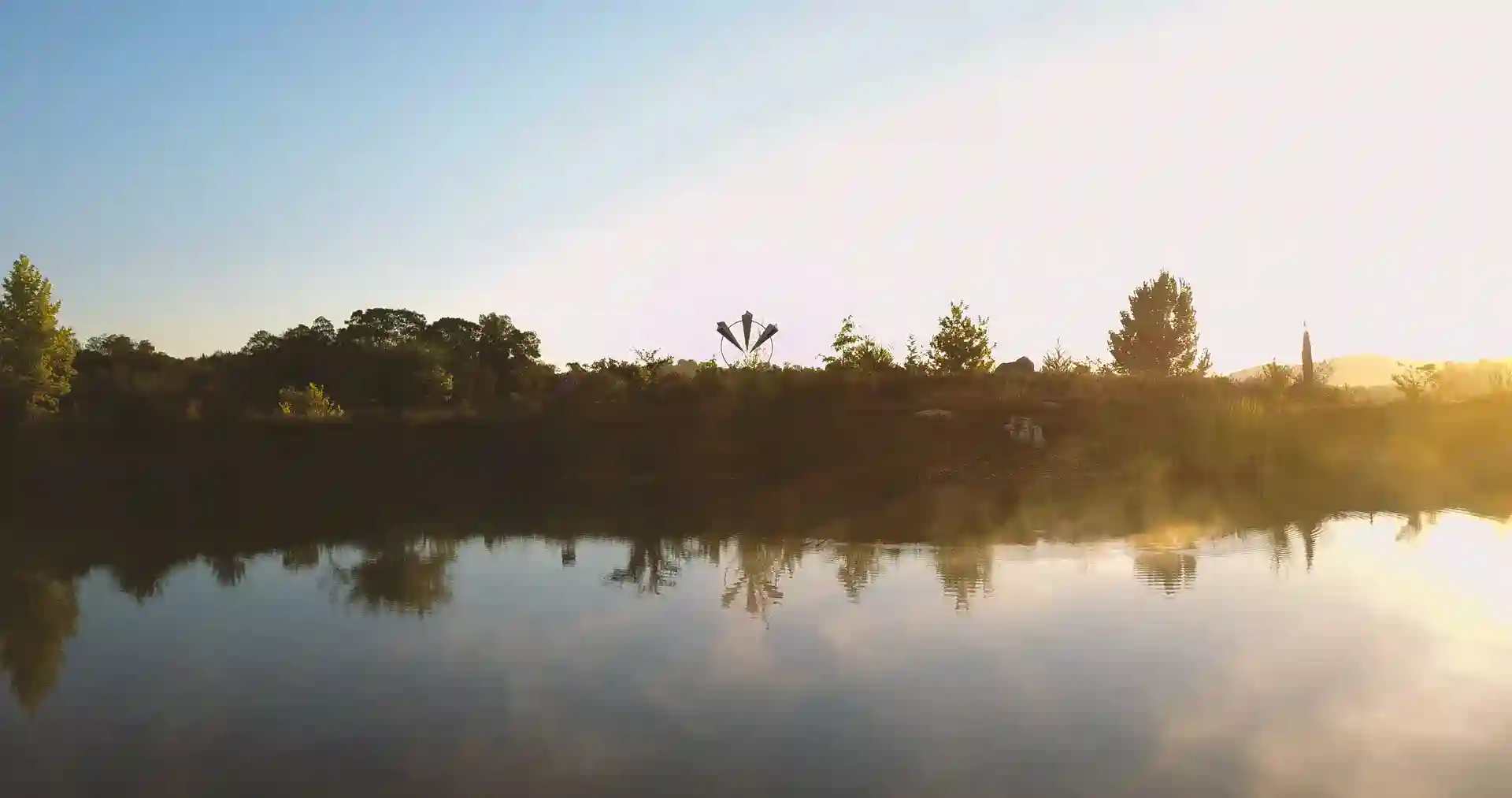The New Water Paradigm
Global Climate and Ecosystem Restoration
Bernd Walter Mueller, edited by Helena Laughton, July 2016

The New Water Paradigm is a paradigm of natural water management. It results in a Global Action Plan of Regenerative Ecosystem and Climate Restoration which has been described by Michal Kravčík. It involves the mobilization of millions of people in hundreds of thousands of decentralized water management projects worldwide. These diverse projects all have the goal of restoring and making best use of natural water cycles for regenerative ecosystem restoration.
Most global water-related crises, such as water scarcity, drought, desertification, flooding, rising sea levels and climate change are symptoms of long-term mismanagement of rainwater and vegetation. This results in global disruptions to natural water cycles. Responding to these problems with industrial methods of control and mitigation is not a viable solution. These unsustainable methods can be superseded by the New Water Paradigm, which underpins the Global Action Plan (GAP). This global plan proposes a holistic response which will simultaneously address all of these problems.
One important element of the GAP is the comprehensive, integrative design of Water Retention Landscapes that are implemented as holistic models at the scale of regional watersheds. Grassroots restoration movements can draw support and inspiration from these model projects, resulting in an increasingly widespread decentralized movement worldwide. Thus global restoration is achieved through local action.
Implementing the New Water Paradigm has three interconnected outcomes:
Regenerative Ecosystem Restoration
Climate Restoration
Social Regeneration
Regenerative Ecosystem Restoration
An abundance of water and food can become possible for all people on Earth, if principles of natural water management are understood and implemented.
This understanding and its implementation leads to worldwide ecosystem restoration.
The crucial principles of natural water management are:
decentralization of water management
prevention of unnecessary runoff through infiltration of rainwater into the Earth body
abundant re-vegetation of watersheds.
Restoring natural water cycles is only possible through localized, decentralized activity. In order for people to take responsibility and act meaningfully to restore their local ecosystems, water management needs to be considered primarily at the level of each watershed. Decentralized movements have short, effective feedback loops, allowing people to see and feel the effects of their own actions. Ordinary people are empowered to restore the landscapes they live in and to see how responsible water management benefits their own lives. Following the principles of the New Water Paradigm, decentralization of water management also enables the re-diversification of regional agriculture. Large-scale, centralized projects do not offer the same advantages.
In reality today, natural water cycles all over the world are broken. Rainwater cannot infiltrate into the ground due to soil erosion and mismanagement of vegetation. This is mainly caused by industrial agricultural practices and widespread surface sealing in urban areas. Rainwater runoff deprives ecosystems of necessary water and steadily dries them out. Groundwater tables drop and springs dry up, accelerating desertification. Rainfall patterns grow more extreme and cause infrastructure damage, river pollution and flooding. Thus ecosystems are destroyed, extreme water events increase and agriculture becomes more and more difficult.
To reverse this situation, the first step is to implement rainwater retention measures which allow rainwater to infiltrate into the Earth body and vegetation to increase again, restoring topsoil. Natural water cycles are the prerequisite for the restoration of intact ecosystems, and thus for the development of regenerative agriculture.
In an ecosystem with intact natural water cycles, much of the earth is shaded and rooted by diverse vegetation. A layer of rich humus topsoil, protected by this dense vegetation, absorbs the majority of rainwater. From there rainwater slowly infiltrates into the ground, recharging aquifers and re-emerging as mineralized, vitalized spring water. The Earth body serves as a buffer, absorbing even strong rainfall. When aquifers are saturated, water is available in springs and wells, even during the dry season. Rivers composed of constantly flowing spring water meander through the land and flow to the sea.
Climate Restoration
Natural water management is not only the key to regenerative ecosystem restoration, but even more radically, it is crucial for climate restoration. Destructive climate change, including global warming and resulting natural disasters such as hurricanes is usually attributed to rising greenhouse gas emissions. It is also true, however, that desertification and the destruction of natural water cycles are major contributors to climate change. Through the restoration of natural water cycles we can restore the climate to beneficial conditions. This means we can aim much higher than mere climate adaptation – we can aim for true climate restoration.
There are three clear examples of the link between natural water management and climate restoration:
the link between falling groundwater tables and rising sea levels
carbon fixing by vegetation
water vapor’s role in energy balance.
Humanity’s current activities are systematically lowering the infiltration of rainwater into the soil. Thus more water flows from the continents into the oceans than is transferred from ocean to land as rain. In this process, the land steadily loses more and more water and dries out. This leads to a drop of the continental groundwater table on one side, and to continuously rising sea levels on the other side. In an intact ecosystem with balanced natural water cycles, some rainwater is used by vegetation, and some evaporates again. But the majority is absorbed into the Earth body. Under these conditions, balance is maintained between water flowing from the continents into the oceans and water transferred from oceans to land as rain. The groundwater table thus remains stable. The Earth body has enough water storage capacity to prevent rainwater from running off the land and contributing to rising sea levels.
The restoration of natural water cycles is inextricably linked to growth in vegetative cover. This results in the binding of large quantities of carbon in the visible vegetation and in extensive root systems in the Earth body. This represents the reversal of carbon emissions, one of the most important greenhouse gases. The reversal of carbon emissions is thus a side effect of ecosystem restoration according to the New Water Paradigm.
In an intact ecosystem, much water evaporates and evapotranspirates from vegetation into the atmosphere. Evaporation of water is an process that consumes energy and thus cools the earth’s crust. This movement of water from the earth’s crust to the atmosphere is a thermoregulatory process that maintains the proper temperatures for life on Earth. In urban areas where the surface is sealed, desertified landscapes, and other damaged ecosystems with high rainwater runoff, this process is interrupted. The natural cycles of evaporation and evapotranspiration, which depend on soil and vegetation, cease to function. Then the energy which was once used in evaporation heats the earth directly, contributing significantly to global warming.
Social Regeneration
Ecosystem and climate restoration through natural water management offers many opportunities for social regeneration:
meaningful employment and education
cultural renewal
improved living standards.
Implementing Integrative Watershed Management projects according to the New Water Paradigm requires a large workforce. This provides millions of meaningful medium- and long-term jobs, and is an unprecedented opportunity for holistic education that benefits both society and the Earth. It can give young adults education in ecological design and its practical implementation. When young people have such an abundance of meaningful work, they benefit from a sense of purpose. They are empowered to play a valuable role in serving the community.
Integrative Watershed Management includes a reappraisal of water’s role in the cultural landscape. It involves reconnection to one’s local watershed and to the local human community. It catalyzes renewed interest in local traditions of honoring and celebrating springs and rivers. This strengthens cooperation between the inhabitants of watersheds who take on responsibility for the ecosystems they inhabit. As such it is an opportunity to build new community networks through a shared task and purpose, on the basis of the New Water Paradigm. Cooperation with nature becomes a common value, and people recognize the responsibility they carry for the well-being of future generations.
All over the world, living standards are improved when people have sufficient easy access to good water. Ecosystem restoration diminishes the threat of extreme water events and improves agricultural conditions. This ameliorates the lives of millions of people, both in the Global South and in the Global North.
Ensuring water abundance through decentralized management leads to greater community resilience. This helps to protect living conditions even in times of crisis.
Conclusion
The New Water Paradigm and the Global Action Plan of Regenerative Ecosystem and Climate Restoration (GAP) offer a holistic response to many global water-related crises today. The implementation of this paradigm, in holistic models and in widespread movements, has a profound, yet swift, effect on the well-being of life on Earth.
Case Studies of Regenerative Ecosystem Restoration
There are many examples of the implementation of the New Water Paradigm in Natural Water Management.
For further discussion of the link between Natural Water Management and climate restoration, see “Water for the Recovery of the Climate: A New Water Paradigm,” by M. Kravčík, J. Pokorny, J. Kohutiar, M. Kovac and E. Toth.
Those who wish to implement the GAP plan are encouraged to study the methods, findings and successes of the following projects and theories:
People and Water (Slovakia)
Ecosystem Restoration and the New Water Paradigm
ludiaavoda.sk
theflowpartnership.org/people-and-water
Loess Plateau Watershed Rehabilitation Project (China)
Large-scale Watershed Rehabilitation
eempc.org/loess-plateau-watershed-rehabilitation-project
The Savory Institute (worldwide)
Holistic Management
savory.global
Tamera, Healing Biotope 1 (Alentejo, Portugal)
Water Retention Landscape Design
https://www.tamera.org/global-ecology-institute/
Report on Presentation of New Water Paradigm at COP22 Morocco
Tarun Barat Sangh (Rajasthan, India)
Large-scale Water Retention Landscape Design
tarunbharatsangh.in
TreePeople (Los Angeles, U.S.A.)
Urban Rainwater Harvesting and Ecosystem Restoration
treepeople.org
Yeomans’ Keyline Plan (worldwide)
Topsoil Restoration and Regenerative Agriculture
permaculturenews.org/2013/02/22/before-permaculture-keyline-planning-and-cultivation
soilandhealth.org/wp-content/uploads/01aglibrary/010125yeomans/010125toc.html

